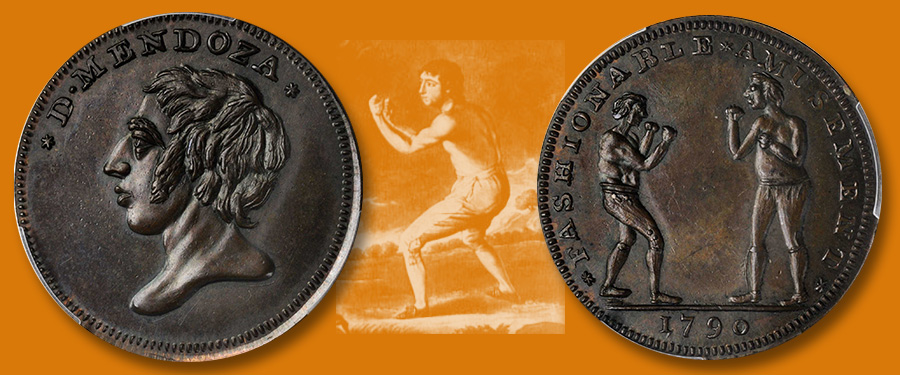
Though neither pugilistic technique—be it in boxing or in MMA (mixed martial arts)—nor the idea of pay-per-view are anything new, these concepts weren’t always the case in the world of combat sports and entertainment. Prior to the late 18th century, boxers generally stood still, attempting to land blow after blow on their opponent until one fighter was left standing; no attempts were made to act defensively or in anticipation. Likewise, back alley or pub fighting was commonplace, with the event serving more as a chance to gamble on the eventual winner than as an actual spectacle for which patrons would pay to view. All of this changed with Daniel Mendoza, a somewhat undersized Sephardic Jew born in Whitechapel in 1764.
Daniel Mendoza grew up in a fairly poor family of Spanish and Portuguese Jewish descent (known as Sephardic), in the East End of London. Following his education, he worked a number of blue collar and semi-skilled jobs, before eventually competing in his first fight at the age of 16. In this initial bout, he acted on behalf of his employer in order to settle a dispute over a delivery of tea. Despite being vastly inferior in stature to his rather burly opponent, Mendoza quickly developed a reputation for his success but also his revolutionary, "scientific" approach. This style incorporated various techniques, such as stance (having one’s knees somewhat bent and fists raised while arms extended, providing better balance and an ability to deflect an incoming punch) and side-stepping (having the ability to roll out of a blow or to cause one’s opponent to throw an erroneous punch, leaving that opponent vulnerable to a counterpunch). These new tactics, seemingly obvious today, allowed Mendoza to compete quite easily with men who vastly outsized him.
In addition to his new style, Mendoza was also at the center of another aspect that would revolutionize the sport—paid admission. Up until the late 1780s, boxing wasn’t really a form of entertainment that someone would purely care to view. Instead, just like cockfighting, it provided a spectacle on which wagers could be placed, facilitating gamblers. Mendoza’s manager and mentor, Richard Humphries, saw an opportunity to capitalize on the fighter’s newfound popularity, scheduling a series of four fights between 1787 and 1790. For the second of these bouts, they collaborated on the price of admission, as droves of patrons sought to watch the dual. Humphries even employed the earliest form of "trash talk" through hyping the event in the media of the day—the newspaper. In so doing, even more interest was attracted, and a new business model—where none had really existed before—was created. Despite the popularity and massive sums of money involved in boxing and MMA today, the idea that one could bring more attention and hype to an impending fight merely by jabbing verbally with the opponent was unparalleled before "the Star of Israel" a.k.a. "Mendoza the Magnificent."
Though able to create a well-known name for himself, helping to raise the image of Jews in England (in a time when antisemitism was rampant) and pocketing a good deal of money along the way, Mendoza proved far less skilled with his earnings and finances than with his footwork. Later life found him serving numerous stints in debtors’ prison, as he was never able to manage successfully the popularity that he enjoyed in the late 1780s and early 1790s. Upon his death at the age of 72 in 1836, his wife and family of 11 children were left in poverty, wholly unaware of the role that he had played in what would one day amount to a sports entertainment industry.
Capturing Mendoza’s iconic status in this period is a rather interesting "Conder" token dated 1790 that will be offered in our February CCO (Collectors Choice Online) auction. This lustrous Gem, graded PCGS MS-65 Brown (tied with just one other example for the finest in their census records), features Mendoza’s bust on the obverse along with his name, "D•MENDOZA." The reverse shows two fighters squaring off and, though both have their fists raised, one can’t help but notice that the pugilist on the left has a bit better stance, possibly a nod to Mendoza’s newly observed tactics. Around the combatants is the phrase "FASHIONABLE AMUSEMENT," encompassing the contemporary feelings about the craze that Mendoza had set off.
To view our upcoming auction schedule and future offerings, please visit StacksBowers.com where you may register and participate in this and other forthcoming sales.
We are always seeking coins, medals, and pieces of paper money for our future sales, and are currently accepting submissions (until May 4th) for our June 2020 CCO (Collectors Choice Online) auction. Before that, however, our next larger format sale will be our Official Auction of the Hong Kong Show in March 2020—a monumental event that will mark our tenth anniversary of auctions in Asia! If you would like to learn more about consigning, whether a singular item or an entire collection, please contact one of our consignment directors today and we will assist you in achieving the best possible return on your material.





